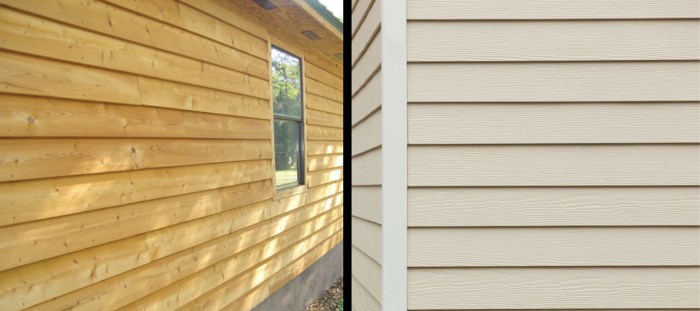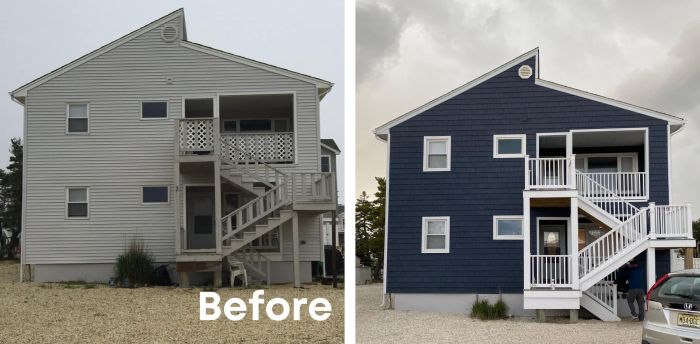Cost of Replacing Wood Siding with Vinyl: Factors, Benefits, Steps, and Environmental Impact
Exploring the cost implications of replacing wood siding with vinyl opens up a world of factors to consider. From installation expenses to long-term maintenance, this comparison sheds light on the financial aspects of siding replacement projects.
Factors affecting the cost difference between wood and vinyl siding replacement
When considering the cost disparity between replacing wood siding with vinyl siding, several factors come into play. Let's explore the various elements that contribute to the overall expenses involved in this home improvement project.
Installation Costs
The installation costs for wood siding are typically higher than vinyl siding due to the labor-intensive nature of working with wood. Wood siding requires more time and effort to install properly, leading to increased installation expenses.
Material Costs
In terms of material costs, wood siding is generally more expensive than vinyl siding. Wood is a natural material that tends to be pricier and requires ongoing maintenance to preserve its appearance. On the other hand, vinyl siding is a more cost-effective option that requires minimal upkeep, making it a more economical choice in the long run.
Maintenance Expenses
Wood siding necessitates regular maintenance, such as painting, staining, and sealing, to protect it from the elements and maintain its aesthetic appeal. These maintenance tasks can add up over time, increasing the overall cost of wood siding replacement. Vinyl siding, on the other hand, is relatively low maintenance, requiring only occasional cleaning to keep it looking its best.
Additional Costs
Beyond installation and material costs, there are additional expenses to consider when replacing wood siding with vinyl siding. Labor costs, tools required for the job, and permits may all contribute to the total replacement expenses. Labor costs can vary depending on the complexity of the project and the location, while tools and permits may incur additional fees that should be factored into the overall budget.
Benefits of replacing wood siding with vinyl

Replacing wood siding with vinyl offers numerous advantages that make it a popular choice for homeowners looking to upgrade their exteriors. Vinyl siding is known for its durability, low maintenance requirements, and longevity, making it a cost-effective option in the long run.
Durability and Maintenance
- Vinyl siding is highly durable and resistant to rot, warping, and pests, unlike wood siding which is prone to damage over time.
- Requires minimal maintenance, only needing occasional cleaning with soap and water to keep it looking new.
- Eliminates the need for regular painting and staining, saving time and money on upkeep.
Energy Efficiency and Insulation
- Vinyl siding offers better insulation properties compared to wood siding, helping to regulate indoor temperatures and reduce energy costs.
- Improves the overall energy efficiency of the home by minimizing heat loss in the winter and heat gain in the summer.
- Enhances the comfort of living spaces by maintaining a consistent temperature throughout the year.
Cost Savings
- Choosing vinyl siding can lead to significant cost savings over time due to its low maintenance requirements and long lifespan.
- Reduces the need for frequent repairs and replacements, minimizing additional expenses associated with wood siding.
- Increases the overall value of the home, offering a high return on investment when it comes to resale or property value appreciation.
Steps involved in the process of replacing wood siding with vinyl

When replacing wood siding with vinyl, there are several key steps involved to ensure a successful installation.
Removal of Existing Wood Siding
- Begin by carefully removing the existing wood siding from the exterior of the house.
- Use a pry bar to detach the wood siding panels from the wall.
- Inspect the underlying structure for any damage or rot that may need to be repaired before installing the vinyl siding.
Installation of Vinyl Siding
- Prepare the surface by installing a moisture barrier and insulation to improve energy efficiency.
- Measure and cut the vinyl siding panels to fit the dimensions of the house.
- Start at the bottom of the wall and work your way up, securing each panel with nails or clips.
Tools and Materials Required
- Vinyl siding panels
- Moisture barrier
- Insulation
- Pry bar
- Nails or clips
- Tape measure
- Saw for cutting
Preparation Work
- Inspect the exterior of the house for any underlying damage or rot that needs to be addressed before installing vinyl siding.
- Clean the surface thoroughly to ensure proper adhesion of the new vinyl siding.
- Check for any obstacles or obstructions that may impede the installation process.
Environmental impact of wood versus vinyl siding replacement

When considering the environmental impact of replacing wood siding with vinyl, it is essential to weigh the eco-friendliness of each material and their sustainability factors.
Eco-friendliness of Wood Siding
Wood siding is a natural material that is biodegradable and renewable, making it a more eco-friendly option compared to vinyl. The sourcing of wood from sustainably managed forests can further enhance its environmental benefits.
Environmental Implications of Vinyl Siding
Vinyl siding, on the other hand, is a synthetic material derived from non-renewable resources such as petroleum. The production and disposal of vinyl materials can have negative environmental implications, including the release of toxic chemicals.
Carbon Footprint Considerations
Choosing wood siding over vinyl can reduce the carbon footprint of a property, as wood has a lower environmental impact throughout its lifecycle. Opting for sustainably sourced wood can also contribute to carbon sequestration, helping mitigate climate change.
End of Discussion
In conclusion, the decision to switch from wood to vinyl siding involves a thorough examination of costs, benefits, and environmental considerations. By understanding the various aspects of this transition, homeowners can make informed choices that align with their budget and values.
FAQ Corner
What are the main factors influencing the cost difference between wood and vinyl siding replacement?
The main factors include installation costs, material costs, and long-term maintenance expenses.
How does choosing vinyl siding over wood benefit homeowners?
Vinyl siding offers advantages in terms of durability, low maintenance, and potential long-term cost savings.
What steps are involved in replacing wood siding with vinyl?
The process includes removing existing wood siding, installing vinyl siding, and preparing the property for the transition.
What is the environmental impact of wood versus vinyl siding replacement?
Wood siding is generally considered more eco-friendly, while vinyl siding may have implications on sustainability and carbon footprint.




